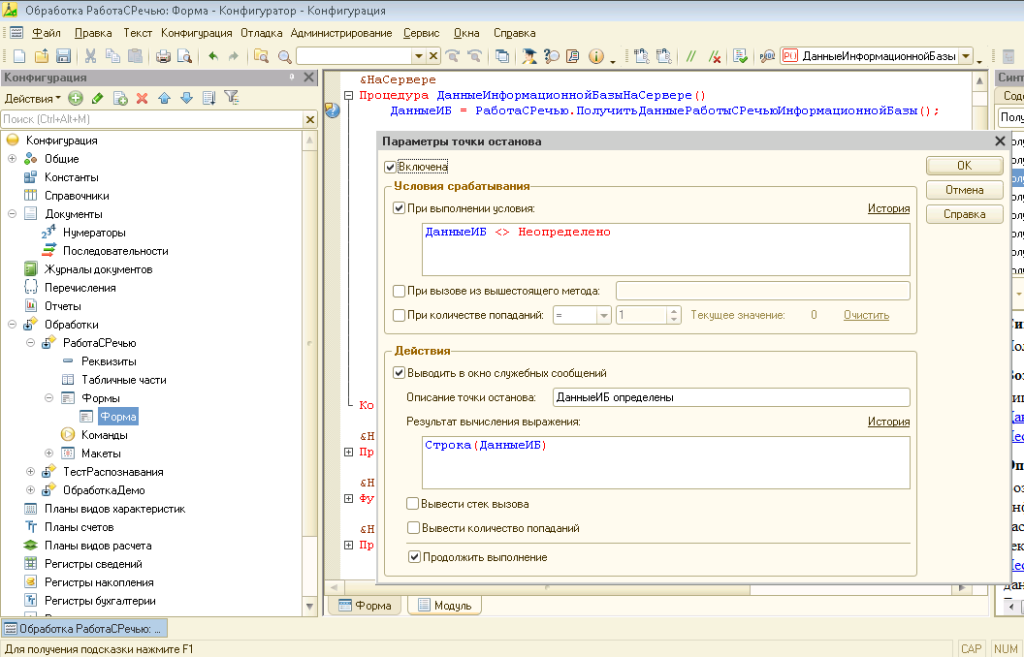
Based on numerous requests from users and partners, buffer handling via the programming language has been added to the platform:
• Adding and reading text, images, and HTML documents to/from the buffer;
• Retrieving files from the buffer in binary format;
• Handling events related to adding images or files from the buffer.
This innovation allows more efficient integration with office applications.
The new version introduces a function for the automatic deletion of unused older versions of the "1C:Enterprise" system. This process works as follows:
• When the system detects unused versions, it prompts the user to delete them;
• The deletion operation is performed via a low-priority background process;
• Users can set exceptions for specific versions never to be deleted;
• It is possible to set automatic deletion for versions installed before a certain date.
This mechanism ensures that the platform remains clean and optimized regularly.
Updates have been made to the search system in the new version to make results more relevant and efficient:
• Search accuracy has been increased, and results are sorted in a more appropriate order;
• A date indicator has been added to the search system by document type:
- For documents – document date;
- For periodic registers – registration period;
- For other objects – the most recent dated attribute is used.
These changes ensure faster and more accurate display of results.
• It is now possible to insert formatted text into table document cells;
• New functions for diagrams:
- Pie charts can be split into selected segments;
- Depth parameters have been added for 3D diagrams;
- Animations are shown when users make changes to charts;
• External navigation links are now generated according to session parameters.
These updates increase the platform’s visual appeal and ease of use.
• "1C:Enterprise" can now work with external storage services based on the S3 protocol;
• A deduplication system has been implemented to prevent data duplication:
• Automatic deduplication during writing;
• Deduplication of already written data in the background mode.
The debugging process has been significantly improved in the new version. Developers can now benefit from the following new features:
• The ability to set breakpoints at the method level – users can pause functions and procedures by specific methods. This helps better understand the program flow.
• Breakpoints for repetitive commands – particularly useful for analyzing loop operators and helps with performance optimization.
• Automatic logging of debugging data – it's possible to jump to the analyzed part of the code via messages, which is a major advantage for developers.
• Flexible management of breakpoints within code – during analysis, it is possible to make changes and move breakpoints up and down.
• "Continue execution" option – during debugging, it's possible to analyze data without fully stopping execution. This function optimizes code performance and increases productivity.

• Adding personal data sources – users can now create and manage their own data sources.

• Automatic database testing and correction – the system supports large-scale checks and auto-correction functions.
• Optimization of the database locking mechanism – new mechanisms ensure secure data storage.
• Improved processes for workload balancing – distribution of database loads has been optimized, enhancing overall system performance.
• Message status display – users can see whether a message has been read, unread, or partially read.
• WhatsApp integration – not only text, but also images, videos, and files can be sent.
• Video conferencing improvements – the speaking participant can now be visually distinguished.
• Improved audio quality for calls over RDP – sound transmission has been enhanced for remote desktop connections.
• New Webhooks support – the platform now supports sending data via Webhooks, which simplifies integration and increases the efficiency of automated operations.
• Full-text search accuracy has been increased – new algorithms rank results more appropriately and make the search process more efficient.
• Automatic deletion of old versions – the system for deleting unused platform versions optimizes performance and storage use.
• Storage of binary data via the S3 protocol – cloud-based data storage functionality has been introduced, optimizing the use of system resources.
• Faster indexing – the speed of index creation and optimization in databases has been improved, resulting in faster queries and output.
• Formatted text can now be added to data tables – information in tables can be presented in a more readable format.
• Improved diagrams – clearer and more visually appealing diagrams are now available for users.
• Optimized navigation system – external links now work faster within the system, simplifying access to information.
• Interactive diagram functions – users can analyze data more thoroughly in a visual format.
• Users can now manage their own sessions – unnecessary sessions can be closed, improving system security.
• Management of data change history – changes can now be easily managed from the user interface.
• Application optimization on the Linux platform – features have been added to make "1C:Enterprise" run more stably on Linux systems.
• Encryption and password policies – platform security has been enhanced with stronger password policies and encryption protocols.
• New authentication mechanisms – secure login is now supported via QR code and mobile identification.
These updates improve system security and provide administrators with broader control capabilities.
13-Dec-2023 384
You can get advice, clarify prices and order a solution from the specialists of 1C OPTIMA AZERBAIJAN. Contact us by phone, e-mail or request a call back.